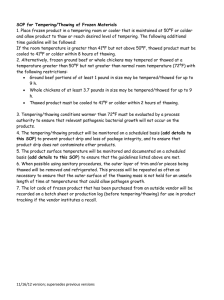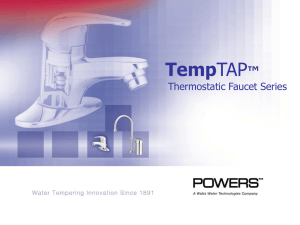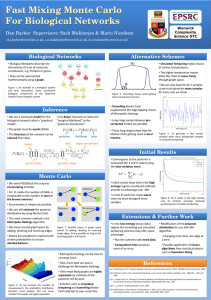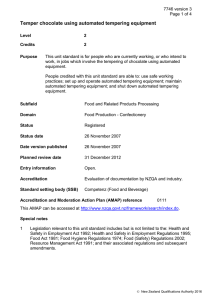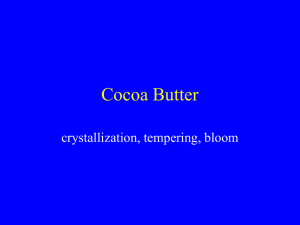Tempering of Fasteners - Heat Treat Doctor.com
advertisement
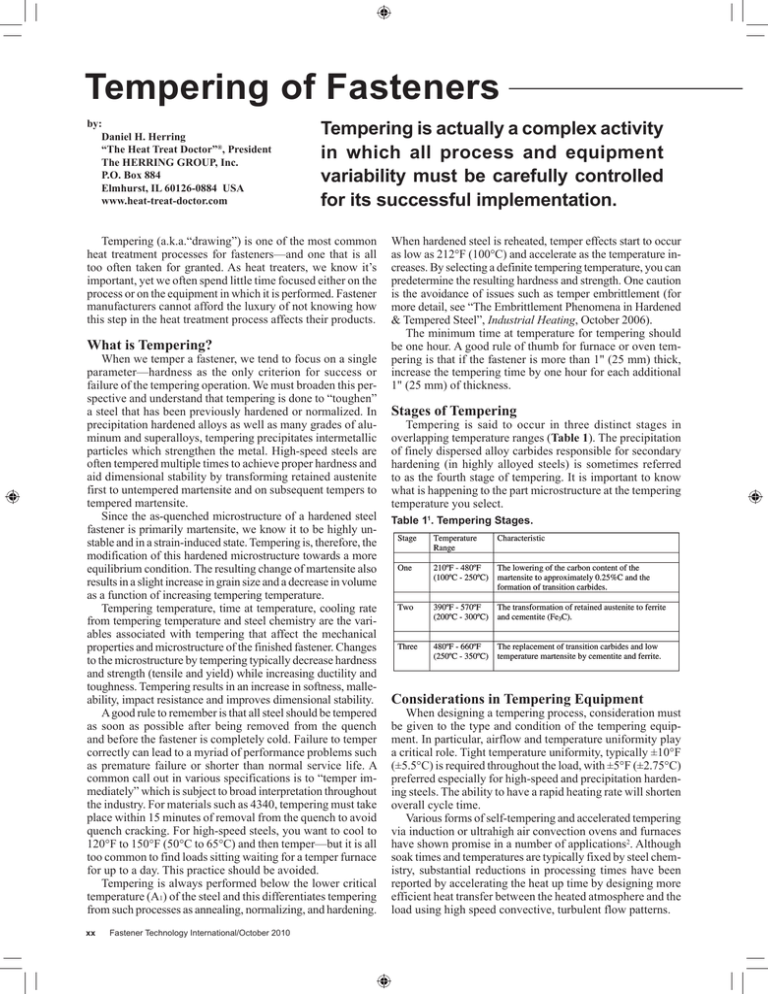
Tempering of Fasteners by: Daniel H. Herring “The Heat Treat Doctor”®, President The HERRING GROUP, Inc. P.O. Box 884 Elmhurst, IL 60126-0884 USA www.heat-treat-doctor.com Tempering is actually a complex activity in which all process and equipment variability must be carefully controlled for its successful implementation. Tempering (a.k.a.“drawing”) is one of the most common heat treatment processes for fasteners—and one that is all too often taken for granted. As heat treaters, we know it’s important, yet we often spend little time focused either on the process or on the equipment in which it is performed. Fastener manufacturers cannot afford the luxury of not knowing how this step in the heat treatment process affects their products. What is Tempering? When we temper a fastener, we tend to focus on a single parameter—hardness as the only criterion for success or failure of the tempering operation. We must broaden this perspective and understand that tempering is done to “toughen” a steel that has been previously hardened or normalized. In precipitation hardened alloys as well as many grades of aluminum and superalloys, tempering precipitates intermetallic particles which strengthen the metal. High-speed steels are often tempered multiple times to achieve proper hardness and aid dimensional stability by transforming retained austenite first to untempered martensite and on subsequent tempers to tempered martensite. Since the as-quenched microstructure of a hardened steel fastener is primarily martensite, we know it to be highly unstable and in a strain-induced state. Tempering is, therefore, the modification of this hardened microstructure towards a more equilibrium condition. The resulting change of martensite also results in a slight increase in grain size and a decrease in volume as a function of increasing tempering temperature. Tempering temperature, time at temperature, cooling rate from tempering temperature and steel chemistry are the variables associated with tempering that affect the mechanical properties and microstructure of the finished fastener. Changes to the microstructure by tempering typically decrease hardness and strength (tensile and yield) while increasing ductility and toughness. Tempering results in an increase in softness, malleability, impact resistance and improves dimensional stability. A good rule to remember is that all steel should be tempered as soon as possible after being removed from the quench and before the fastener is completely cold. Failure to temper correctly can lead to a myriad of performance problems such as premature failure or shorter than normal service life. A common call out in various specifications is to “temper immediately” which is subject to broad interpretation throughout the industry. For materials such as 4340, tempering must take place within 15 minutes of removal from the quench to avoid quench cracking. For high-speed steels, you want to cool to 120°F to 150°F (50°C to 65°C) and then temper—but it is all too common to find loads sitting waiting for a temper furnace for up to a day. This practice should be avoided. Tempering is always performed below the lower critical temperature (A1) of the steel and this differentiates tempering from such processes as annealing, normalizing, and hardening. xx Fastener Technology International/October 2010 When hardened steel is reheated, temper effects start to occur as low as 212°F (100°C) and accelerate as the temperature increases. By selecting a definite tempering temperature, you can predetermine the resulting hardness and strength. One caution is the avoidance of issues such as temper embrittlement (for more detail, see “The Embrittlement Phenomena in Hardened & Tempered Steel”, Industrial Heating, October 2006). The minimum time at temperature for tempering should be one hour. A good rule of thumb for furnace or oven tempering is that if the fastener is more than 1" (25 mm) thick, increase the tempering time by one hour for each additional 1" (25 mm) of thickness. Stages of Tempering Tempering is said to occur in three distinct stages in overlapping temperature ranges (Table 1). The precipitation of finely dispersed alloy carbides responsible for secondary hardening (in highly alloyed steels) is sometimes referred to as the fourth stage of tempering. It is important to know what is happening to the part microstructure at the tempering temperature you select. Table 11. Tempering Stages. Considerations in Tempering Equipment When designing a tempering process, consideration must be given to the type and condition of the tempering equipment. In particular, airflow and temperature uniformity play a critical role. Tight temperature uniformity, typically ±10°F (±5.5°C) is required throughout the load, with ±5°F (±2.75°C) preferred especially for high-speed and precipitation hardening steels. The ability to have a rapid heating rate will shorten overall cycle time. Various forms of self-tempering and accelerated tempering via induction or ultrahigh air convection ovens and furnaces have shown promise in a number of applications2. Although soak times and temperatures are typically fixed by steel chemistry, substantial reductions in processing times have been reported by accelerating the heat up time by designing more efficient heat transfer between the heated atmosphere and the load using high speed convective, turbulent flow patterns. Temper Colors The use of temper color is one method of not only visually determining if a fastener has been exposed to the proper tempering temperature, but to check if all parts in a given load reached a uniform temperature. When steel is heated and exposed to air (or an oxidizing atmosphere) for a short period of time it will change color due to the presence of a thin, tightly adhering oxide. The temper color and thickness of the oxide layer varies with both time and temperature (Table 2). Different steel chemistries also result in slight color variations. The colors produced are typically not uniform, because of surface condition and fluctuation of temperature. In order to see the colors clearly, you must turn the part from side to side and have good lighting. Natural lighting is always best. Table 2. Steel Color Changes as a Function of Tempering Temperature. Case Study As an example, a fastener manufacturer was interested in establishing the relationship between tempering temperature and (final) hardness for a number of common fastener materials (see Table 3) while holding the hardening parameters constant. A number of controlled tests was conducted (Table 4 on next page of this article) in order to develop the desired relationship (Figure 1 on next page of this article) targeting values in the middle of the targeted range. Charts or graphs developed from testing such as done in this case study simplify the tempering process and make the job of the heat treater easier. Final Thoughts Tempering, because it is often the last heat treating operation, is considered by most to be relatively simple and straightforward yet the heat treater must remember that it is a complex process in which all of the process and equipment variability must be carefully controlled. www.heat-treat-doctor.com References: 1 Krause, G., Steels: Heat Treatment and Processing Principles, ASM International, 1990. 2 Grenier, Mario and George E. Totten, Rapid Stress Relieving and Tempering, Gear Solutions, May 2005. 3 Herring, D. H., What Do We Really Know About Tempering?, Industrial Heating, July 2007. 4 Herring, D. H., The Embrittlement Phnomena in Hardened & Tempered Steel, Industrial Heating, October 2006. Table 3. Materials Selected for Tempering Study. Continued... October 2010/Fastener Technology International xx Tempering of Fasteners ...continued Table 4. Results of Experimental Trials. Fig. 1 — Example of the relationship of tempering temperature to final hardness for selected steels. FTI Company Profile: The HERRING GROUP, Inc. specializes in rapid response to technical and business needs in the heat treating and sintering industry. The Group does its job when and where the customer needs it in the most cost and time-effective manner. The customer’s deadlines and needs are the Group’s only priority. The Group has the ability to understand how to provide information that is useful at every level within an organization, in clear and concise terms. Customers report that by using the Group’s services, they have increased productivity, lowered energy and operating costs, improved worker output and satisfaction and increased company profitability. Customers benefit from the Group’s 25+ years of practical, engineering and scientific training in problem solving, process applications, and “hands on” experience. Attributes of the HERRING GROUP include the following: xx Fastener Technology International/October 2010 • “Hands On” Heat Treater • Metallurgist • Equipment Designer • Team Builder / Team Leader • Process / Application Specialist • Industrial Trainer / Educator • Market & New Product Researcher • Technical Society Volunteer • Author & Lecturer • Materials Scientist • Engineering Manager • Chief Metallurgist • R&D Director / Inventor • Monthly Magazine Columnist • Business Developer • Corporate Executive


